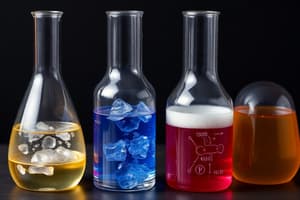Podcast
Questions and Answers
What is the characteristic of a solution that allows it to have a uniform composition throughout?
What is the characteristic of a solution that allows it to have a uniform composition throughout?
- Homogeneity (correct)
- Transparency
- Saturation
- Stability
Which type of solution contains more solute than it can hold at a given temperature?
Which type of solution contains more solute than it can hold at a given temperature?
- Unsaturated solution
- Supersaturated solution (correct)
- Saturated solution
- Homogeneous solution
What is the unit of molarity?
What is the unit of molarity?
- Grams/kilogram
- Moles/kilogram
- Moles/liter (correct)
- Grams/liter
What is the effect of increasing temperature on the solubility of most substances?
What is the effect of increasing temperature on the solubility of most substances?
What is the term for the mass of solute per 100 grams of solution?
What is the term for the mass of solute per 100 grams of solution?
What is the effect of increasing pressure on the solubility of gases?
What is the effect of increasing pressure on the solubility of gases?
What is the primary factor that determines solubility?
What is the primary factor that determines solubility?
What is the effect on the boiling point of a solution compared to the pure solvent?
What is the effect on the boiling point of a solution compared to the pure solvent?
What is the purpose of solutions in laboratory settings?
What is the purpose of solutions in laboratory settings?
What is the effect on the freezing point of a solution compared to the pure solvent?
What is the effect on the freezing point of a solution compared to the pure solvent?
What is the term for the pressure exerted by a solution on a semipermeable membrane?
What is the term for the pressure exerted by a solution on a semipermeable membrane?
Flashcards are hidden until you start studying
Study Notes
Solutions Class 12
Definition of a Solution
- A solution is a homogeneous mixture of two or more substances, where one substance (the solute) is dissolved in another substance (the solvent).
- The solute is present in a smaller amount than the solvent.
Characteristics of Solutions
- Homogeneous: Solutions have a uniform composition throughout.
- Stable: Solutions are stable at a given temperature and pressure.
- Transparent: Solutions are transparent, as the particles are too small to scatter light.
Types of Solutions
- Saturated Solution: A solution that contains the maximum amount of solute that can be dissolved at a given temperature.
- Unsaturated Solution: A solution that contains less solute than it can hold at a given temperature.
- Supersaturated Solution: A solution that contains more solute than it can hold at a given temperature.
Concentration of Solutions
- Mass Percentage: The mass of solute per 100 grams of solution.
- Volume Percentage: The volume of solute per 100 volumes of solution.
- Molarity: The number of moles of solute per liter of solution (M = moles/liter).
- Molality: The number of moles of solute per kilogram of solvent (m = moles/kilogram).
Factors Affecting Solubility
- Temperature: Solubility increases with temperature for most substances.
- Pressure: Solubility increases with pressure for gases.
- Nature of Solvent and Solute: Solubility depends on the interaction between the solvent and solute particles.
Colligative Properties
- Boiling Point Elevation: The boiling point of a solution is higher than that of the pure solvent.
- Freezing Point Depression: The freezing point of a solution is lower than that of the pure solvent.
- Osmotic Pressure: The pressure exerted by a solution on a semipermeable membrane to equalize the concentration of solute particles.
Applications of Solutions
- Medicine: Solutions are used as medicinal preparations, such as injections and syrups.
- Industry: Solutions are used in various industrial processes, such as manufacturing and purification.
- Laboratory: Solutions are used as reagents and solvents in chemical reactions and experiments.
Definition and Characteristics of Solutions
- A solution is a homogeneous mixture of two or more substances, where one substance (the solute) is dissolved in another substance (the solvent).
- The solute is present in a smaller amount than the solvent.
- Solutions are homogeneous, stable, and transparent, with uniform composition throughout.
Types of Solutions
- Saturated Solution: contains the maximum amount of solute that can be dissolved at a given temperature.
- Unsaturated Solution: contains less solute than it can hold at a given temperature.
- Supersaturated Solution: contains more solute than it can hold at a given temperature.
Concentration of Solutions
- Mass Percentage: the mass of solute per 100 grams of solution.
- Volume Percentage: the volume of solute per 100 volumes of solution.
- Molarity (M): the number of moles of solute per liter of solution.
- Molality (m): the number of moles of solute per kilogram of solvent.
Factors Affecting Solubility
- Temperature: solubility increases with temperature for most substances.
- Pressure: solubility increases with pressure for gases.
- Nature of Solvent and Solute: solubility depends on the interaction between solvent and solute particles.
Colligative Properties
- Boiling Point Elevation: the boiling point of a solution is higher than that of the pure solvent.
- Freezing Point Depression: the freezing point of a solution is lower than that of the pure solvent.
- Osmotic Pressure: the pressure exerted by a solution on a semipermeable membrane to equalize the concentration of solute particles.
Applications of Solutions
- Medicine: solutions are used as medicinal preparations, such as injections and syrups.
- Industry: solutions are used in various industrial processes, such as manufacturing and purification.
- Laboratory: solutions are used as reagents and solvents in chemical reactions and experiments.
Studying That Suits You
Use AI to generate personalized quizzes and flashcards to suit your learning preferences.




